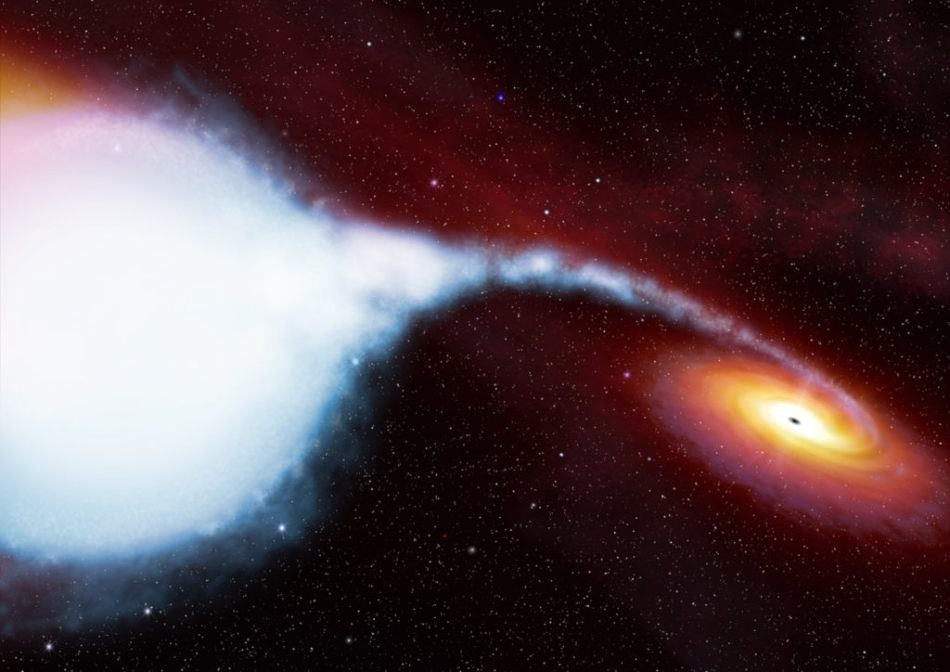Jul 30 2018
In an international association between Sweden and Japan, researchers explained how the shape of matter close to the black hole in the Cygnus X-1 binary system is affected by gravity. This discovery, which was reported in Nature Astronomy, can possibly aid researchers to further fathom the physics of powerful gravity and the emergence of galaxies and black holes.
 The black hole in Cygnus X-1 is one of the brightest sources of X-rays in the sky. The light near the black hole comes from matter siphoned off its companion star. (Image credit: NASA, ESA, Martin Kornmesser)
The black hole in Cygnus X-1 is one of the brightest sources of X-rays in the sky. The light near the black hole comes from matter siphoned off its companion star. (Image credit: NASA, ESA, Martin Kornmesser)
The first black hole discovered in the universe is orbited by a star, close to the middle of the constellation of Cygnus. This black hole and the star together form a binary system called Cygnus X-1. In addition, the black hole is one of the brightest sources of X-rays in the sky. Yet, scientists were clueless about the geometry of matter that gives rise to this bright light. This information was revealed by the research team through a new method known as X-ray polarimetry.
It is not easy to take a picture of a black hole because for one thing, a black hole cannot be observed as light cannot escape it. Therefore, instead of viewing the black hole itself, researchers can view the light emerging from matter near the black hole. With regards to Cygnus X-1, this matter emerges from the star that orbits the black hole closely.
In the sun, most of the light that is seen vibrates in numerous directions. Light is filtered by polarization so that it can vibrate in a single direction. This is similar to how snow goggles equipped with polarized lenses allow skiers to see more effortlessly where they are heading down the mountain; the snow goggles work because light reflecting off of the snow is cut by the filter.
“It’s the same situation with hard X-rays around a black hole,” said Hiromitsu Takahashi, Hiroshima University Assistant Professor and study coauthor. “However, hard X-rays and gamma rays coming from near the black hole penetrate this filter. There are no such ‘goggles’ for these rays, so we need another special kind of treatment to direct and measure this scattering of light.”
The researchers have to find out from which direction the light was coming from and where it scattered. To perform both these measurements, the team introduced an X-ray polarimeter on a balloon known as PoGO+, and from there they can figure out what amount of hard X-rays reflected off the accretion disk and detect the shape of matter.
Two contending models elucidate how matter close to a black hole can appear in a binary system, for example, Cygnus X-1: the extended model and the lamp-post model. In the former model, the corona is larger and distributed around the area of the black hole. In this situation, the light reflected by the disk is weaker. The corona in the latter model is compact and bound proximally to the black hole. Also, photons bend toward the accretion disk, leading to more reflected light.
Under the powerful gravity of the black hole, the light did not bend considerably. The researchers, therefore, reached a conclusion that the black hole fits the extended corona model.
Armed with this data, the team can expose more characteristics regarding black holes. The spin of the black hole is one example. The spin’s effects can alter the space-time enclosing the black hole. In addition, this spin may offer clues on how the black hole evolved. Since the beginning of the universe, it might be slowing down in speed, or it could be building up the matter and spinning faster.
“The black hole in Cygnus is one of many,” said Takahashi. “We would like to study more black holes using X-ray polarimetry, like those closer to the center of galaxies. Maybe we better understand black hole evolution, as well as galaxy evolution.”